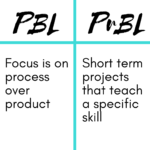What is the difference between problem based and project based learning?
By Dr. Jenny Pieratt
Don’t panic! While questions regarding the difference between problem based (PBL), project based (PrBL), even zombie based learning (yes, it’s a thing) might keep you up at night, there’s no need to stress. As described by Geoff Krall in Emergent Math, the key differences between problem based and project based learning are “size, scope, and end product.” What distinguishes these two methods can help us determine when PBL vs PrBL makes better sense for deeper learning.
Key Differences
PBL can involve interdisciplinary work whilst PrBL is generally implemented in just one class and lasts a few days at most. Contrary to popular belief, PrBL is not any easier to implement than PBL as it also requires the teacher to become a supportive, adaptable facilitator. In PrBL, teachers can set goals and outcomes jointly with students, whereas in PBL, the objectives are usually established by the teacher beforehand. Moreover, both PBL and PrBL are centered on real-world problems, though PrBL can be more abstract in classes like math. One last thing– you can assess PrBL just like you would for PBL, but it’s far easier to construct rubrics as you go, focusing on a select number of skills for each batch of problems. So when is it best to implement PBL vs PrBL? And how can PrBL be used as an extension of PBL?
When PrBL makes sense
Problem-based learning allows you to focus on skills and on the learning process rather than on the product. It works well in classes like math or science where problem-solving might teach students more than product refinement. Regarding math, for instance, PrBL promotes “mathematical habits of mind”, which range from curiosity and persistence to finding patterns and generalizing, to the use of mathematical language and models to interpret phenomena. One idea for PrBL is teaching students to build their own soccer goals using the Pythagorean Theorem. This is a wonderful combination of rigorous mathematics, fun hands-on work, and community service if you plan to give away these soccer goals to the local soccer club. Problem-based learning is also an excellent way to stimulate your foreign language class. For example, this middle school class created print materials in Spanish for migrant workers to help train and inform them. Such a project addresses a real-life issue and gives students both the practice of essential language skills and an authentic learning experience in a short time span. So what does this entail regarding the difference between problem-based and project-based learning? PrBL, contrarily to PBL, works best when it is implemented in a class with fewer standards to follow to teach specific skills that students need to practice.
When PBL is best
So when is PBL worth your while? Project-based learning involves an increased number of standards and time dedicated to learning. This means that PBL is an amazing opportunity for you to get through many of the requirements on your to-do list. That’s one of the differences between problem-based and project-based learning– if you have a lot of standards to follow, then PBL, more so than PrBL, will allow you to make the most out of your class time. It’s also exceptionally easy to incorporate a variety of content areas and interdisciplinary connections through project-based learning. In New Utrecht High School, for instance, students dove into the intriguing world of tourism and worked with the following guiding question: “What makes a place a destination?” They then created marketing strategies and even a website for their “client country”. Want another example? At ARISE Academy, students used a variety of different media outlets to present a civil rights topic of their choice to a panel of judges who asked difficult questions about the choices they made. Such projects help you teach 21st-century skills (such as collaboration or oral communication), making learning meaningful to students. Don’t forget to incorporate extra time for feedback throughout the project for you students to reflect and for you to apply continuous assessment. When thinking of the difference between PrBL and PBL, the key takeaway from this is that PBL is much more time demanding, but also allows you to cover more ground. If you are a math teacher wondering if PBL is the right fit for you, check out this post.
Connecting both– PrBL as an extension of PBL
Of course, you can always switch between PrBL and PBL, and you can also combine them! Problem-based learning can be implemented for every subtopic you cover. The trick is to create a guiding narrative between each of the different problem sets, constructing an overarching frame for project-based learning. Let’s imagine you’re teaching a 9th grade class about linear functions. You can work your way through imaginative problem sets like Taco Cart, Pepsi Points, or the perfect Chocolate Mix, using each example to teach different content. You could then throw in some project-based learning by tying the PrBL sub-units together and asking students to create a new, healthy, cafeteria menu for their school with certain budget constraints. Now that’s a great interdisciplinary project that pushes students to take ownership of their learning. As explained by the Buck Institute of Education in PBL Works, project-based learning represents independence and the exploration of “meaningful questions”– which could also be PrBL exercises. This is why exploiting the difference between problem-based learning and project-based learning can make your teaching even more meaningful to your students.
My favorite resources
–Emergent math curriculum maps
–Necessary conditions by G.Krahl
-Doing Math by Bryan Meyer on Twitter
–Dan Meyer and 3 Acts Real World Math Tasks


